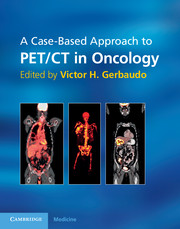Book contents
- Frontmatter
- Contents
- Contributors
- Foreword
- Preface
- Part I General concepts of PET and PET/CT imaging
- Part II Oncologic applications
- Chapter 5 Brain
- Chapter 6 Head, neck, and thyroid
- Chapter 7 Lung and pleura
- Chapter 8 Esophagus
- Chapter 9 Gastrointestinal tract
- Chapter 10 Pancreas and liver
- Chapter 11 Breast
- Chapter 12 Cervix, uterus, and ovary
- Chapter 13 Lymphoma
- Chapter 14 Melanoma
- Chapter 15 Bone
- Chapter 16 Pediatric oncology
- Chapter 17 Malignancy of unknown origin
- Chapter 18 Sarcoma
- Chapter 19 Methodological aspects of therapeutic response evaluation with FDG-PET
- Chapter 20 FDG-PET/CT-guided interventional procedures in oncologic diagnosis
- Index
- References
Chapter 15 - Bone
from Part II - Oncologic applications
Published online by Cambridge University Press: 05 September 2012
- Frontmatter
- Contents
- Contributors
- Foreword
- Preface
- Part I General concepts of PET and PET/CT imaging
- Part II Oncologic applications
- Chapter 5 Brain
- Chapter 6 Head, neck, and thyroid
- Chapter 7 Lung and pleura
- Chapter 8 Esophagus
- Chapter 9 Gastrointestinal tract
- Chapter 10 Pancreas and liver
- Chapter 11 Breast
- Chapter 12 Cervix, uterus, and ovary
- Chapter 13 Lymphoma
- Chapter 14 Melanoma
- Chapter 15 Bone
- Chapter 16 Pediatric oncology
- Chapter 17 Malignancy of unknown origin
- Chapter 18 Sarcoma
- Chapter 19 Methodological aspects of therapeutic response evaluation with FDG-PET
- Chapter 20 FDG-PET/CT-guided interventional procedures in oncologic diagnosis
- Index
- References
Summary
Introduction
The vast majority of malignant bone lesions initiate as bone marrow deposits of malignant cells. As the lesion enlarges, the surrounding bone undergoes osteoclastic (resorptive) and osteoblastic (depositional) activity. Based on the balance between these two processes, lesions may appear radiographically, as lytic, sclerotic (blastic), or mixed (1–3).
Osteosarcoma is the most frequent primary bone malignancy in children and second in adults following multiple myeloma. The Ewing sarcoma family of tumors is the second most frequent primary bone malignancy in children and young adults (4). Bone metastases are the most common malignant bone tumor, with breast cancer being the leading primary tumor in women and prostate cancer in men, followed by lung cancer. The type of metastases and the incidence of metastatic skeletal spread depend on the type of malignancy and the disease stage, respectively (5).
The purpose of imaging is to identify malignant skeletal involvement as early as possible, to determine the extent of the disease, to evaluate the presence of clinically relevant complications (such as fractures or lesions which harbor risk for neurologic deficit), to monitor response to therapy, and at times, to guide biopsy (5, 6).
- Type
- Chapter
- Information
- A Case-Based Approach to PET/CT in Oncology , pp. 406 - 427Publisher: Cambridge University PressPrint publication year: 2012

